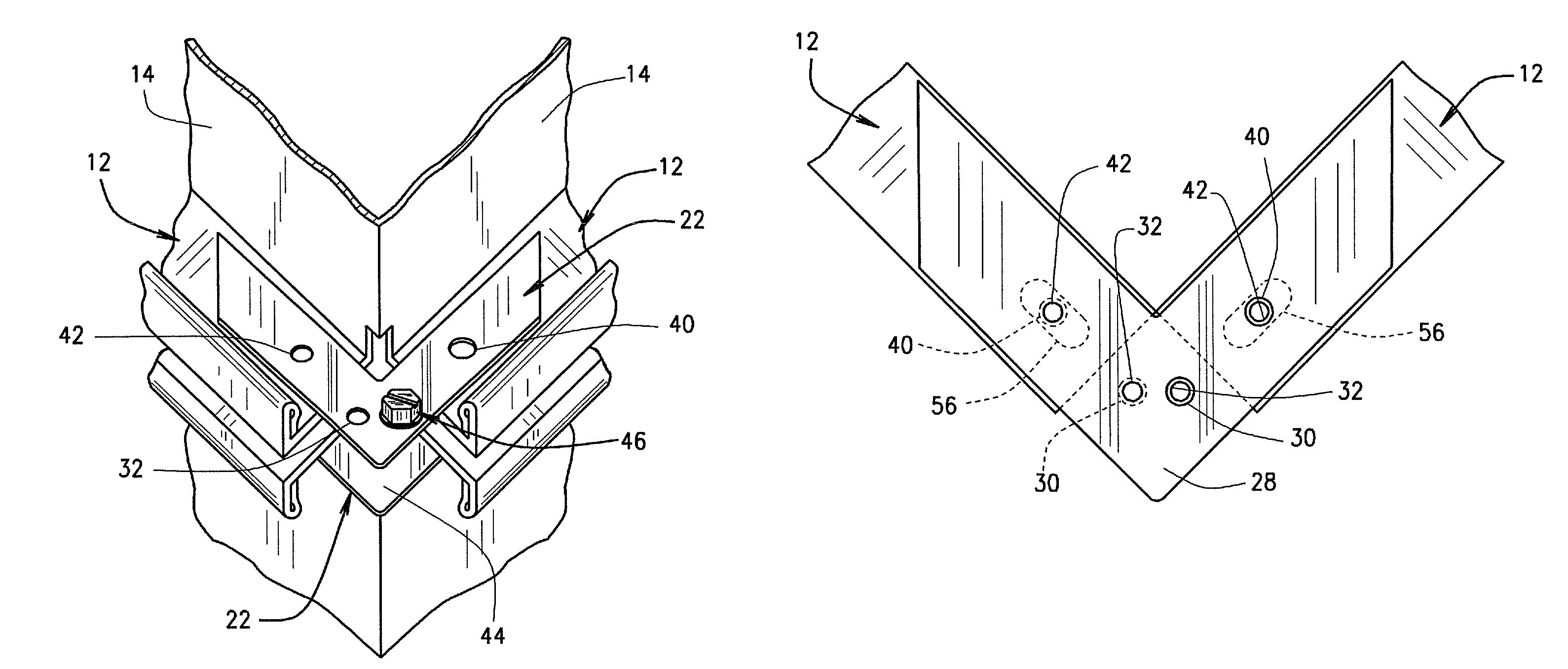Sheet metal corner for duct flanges
a technology of corner flanges and duct flanges, which is applied in the direction of hose connections, lighting and heating apparatus, heating types, etc., can solve the problems that the channel flange does not always produce a completely secure connection, and achieves the effect of reducing the number of crimping
- Summary
- Abstract
- Description
- Claims
- Application Information
AI Technical Summary
Benefits of technology
Problems solved by technology
Method used
Image
Examples
embodiment 70
[0052]FIG. 11 illustrates still another embodiment 70 of a high-speed fastener member for use with the present corner elements 22, the embodiment 70 including a standard bolt 72 and a piloted nut 74. The standard bolt 72 includes a head portion 76 and a threaded portion 78 and the piloted nut 74 includes a non-threaded cavity 80 and a threaded cavity 82. The non-threaded cavity 80 is of a diameter larger than the threaded portion 78 of bolt 72 and larger than the threaded cavity 82 and extends along a portion of the overall length of the piloted nut 74 as illustrated in FIG. 11. The piloted nut 74 could also be a piloted washered nut. The slightly oversized non-threaded cavity 80 serves as a guide mechanism for properly orienting the threaded portion 78 of the standard bolt 72 into the nut 80 before engaging the threaded cavity 82. Like the piloted portions 52 and 68 associated with fasteners 46 and 58, the non-threaded cavity 82 allows the nut 76 to be properly positioned relative ...
embodiment 160
[0068]Joinder of adjacent duct sections utilizing adjacent opposed corner elements 142 can be accomplished through the use a conventional carriage type bolt. In this regard, FIG. 19 illustrates still another embodiment 160 of a high-speed fastener member for use with the present corner elements 142, the embodiment 160 including a standard carriage bolt 162 and a piloted nut 164. The standard carriage bolt 162 includes a head portion 166, a rectangularly shaped relief portion 168, and a threaded portion 170. The piloted nut 164 includes a non-threaded cavity 172 and a threaded cavity 174. The non-threaded cavity 172 is of a diameter larger than the threaded portion 170 of carriage bolt 162 and larger than threaded cavity 174 and extends along a portion of the overall length of the piloted nut 164 as illustrated in FIG. 19. Similar to fastener member 70 illustrated in FIG. 11, the slightly oversized non-threaded cavity 172 serves as a guide mechanism for properly orienting the threade...
PUM
| Property | Measurement | Unit |
|---|---|---|
| diameter | aaaaa | aaaaa |
| height | aaaaa | aaaaa |
| distance | aaaaa | aaaaa |
Abstract
Description
Claims
Application Information
 Login to View More
Login to View More - R&D
- Intellectual Property
- Life Sciences
- Materials
- Tech Scout
- Unparalleled Data Quality
- Higher Quality Content
- 60% Fewer Hallucinations
Browse by: Latest US Patents, China's latest patents, Technical Efficacy Thesaurus, Application Domain, Technology Topic, Popular Technical Reports.
© 2025 PatSnap. All rights reserved.Legal|Privacy policy|Modern Slavery Act Transparency Statement|Sitemap|About US| Contact US: help@patsnap.com



